Framing the Horrors of the Holocaust Through a 21st Century Lens: Making of ‘The Zone of Interest’
- Oops!Something went wrong.Please try again later.
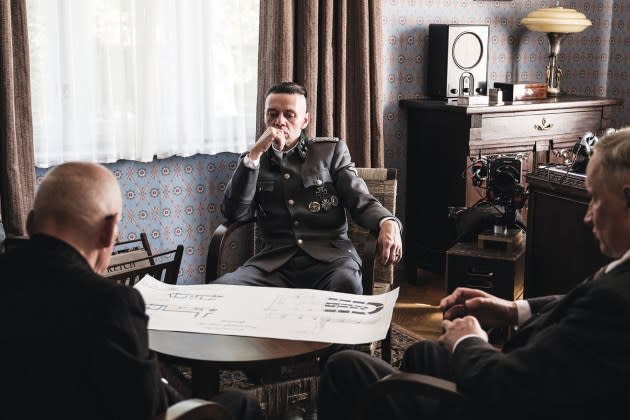
How, given the weight of history, and the history of all the other films on the subject, can you make a new film about the Holocaust?
That was the central challenge facing British writer-director Jonathan Glazer and the creative team behind A24’s The Zone of Interest.
More from The Hollywood Reporter
Jacob Elordi, Ayo Edebiri, Phoebe Dynevor Among BAFTA Rising Star Award Nominees
Rapper Skepta Draws Fire for Song Artwork That Evokes Images of Holocaust
“When Jon and I started, back in 2014, to talk about this, about making a film on this subject, we of course knew Schindler’s List and Son of Saul and everything in between,” says Zone producer James Wilson. “And our conversations were all about, ‘What new is there to say about the Holocaust?’ Except that it was evil, which everyone knows and which felt like a straw target.”
Glazer had been “circling around” the idea of doing a Holocaust film for years. “But because the subject is so vast and because of the sensitivities involved, I felt I first needed to educate myself in a deeper way,” he says. “So I spent a couple of years just reading books on the subject, watching documentaries, reading eye-witness testimony. Trying to understand the impulses that drew me to the subject to begin with, before I even tried to put pen to paper.”
During his research, Glazer came across an excerpt from The Zone of Interest, a novel by British writer Martin Amis that told a fictionalized story set in a Nazi concentration camp. Provocatively, the story came in part from the perspective of the camp commandant.
“He was this fictional character, this grotesque but utterly compelling figure called Paul Doll,” says Glazer. “I didn’t know whether I wanted to adapt the book, but I knew there was something in the book for me.”
In 2014, Glazer optioned the film rights to the novel.
“What hooked into Jon was that point of view, that perpetrator point of view,” says Wilson. “The idea of making a Holocaust film from the German Nazi perspective.”
Glazer and Wilson spent the next few years self-financing their own research and development. It quickly became apparent that Paul Doll was inspired by the real-life Rudolf Höss, the longest-serving commandant of the Auschwitz death camp. Höss helped set up the camp and was responsible for transforming it from a prison facility for captured Soviet soldiers and Polish partisans to a murder factory for Jews. He lived next to the camp, in a villa with his wife, Hedwig, and their five children. The dream home was a few hundred meters from the gas chambers and the crematoria, separated only by the camp wall. After the war, and a guilty verdict at the Nuremberg trials, Höss was hanged in Auschwitz, within view of his house.
“The Höss house is still there, and the proximity to the camp is striking,” says Glazer. “I imagined myself at one point as a prisoner, imagining hearing the sounds of the Höss children splashing and laughing in their swimming pool on the other side of the wall. The idea of the film became about that wall, about how that wall is a direct manifestation of how we ourselves as human beings compartmentalize the things we were happy to indulge in and surround ourselves with and the things — sometimes horrible things — we want to disassociate ourselves from. That became the axiom of the whole endeavor.”
Dropping the idea of adapting the fictional story of Amis’ novel, Glazer shifted to trying to tell the story of the Höss family in a way that showed them not as monsters, but as human beings being monstrous.
“The more I read about these people, the Höss family, the more they became demystified to me,” says Glazer. “So much cinema, particularly to do with the Holocaust, shows the perpetrators as almost mythologically evil. I realized I wanted to make a film about these people and their ordinariness. I didn’t want to glorify or fetishize them by accident.”
The process of demystification was two-fold: Glazer and his team would get as close as they could to the actual Höss family through exhaustive historical research. And they would make every effort to strip away the tricks and techniques of moviemaking to tell the story as directly and objectively as possible, without emotional manipulation or heavy-handed moralizing.
After several scouting visits to Auschwitz, it quickly became evident they could not shoot on location in the original Höss house.
“It was just too old,” says Zone production designer Chris Oddy, who also worked with Glazer on 2013’s Under the Skin. “There was no way to overcome those 80 years of decrepitude, all that wear and tear, to make it seem new, as it looked in 1943.”
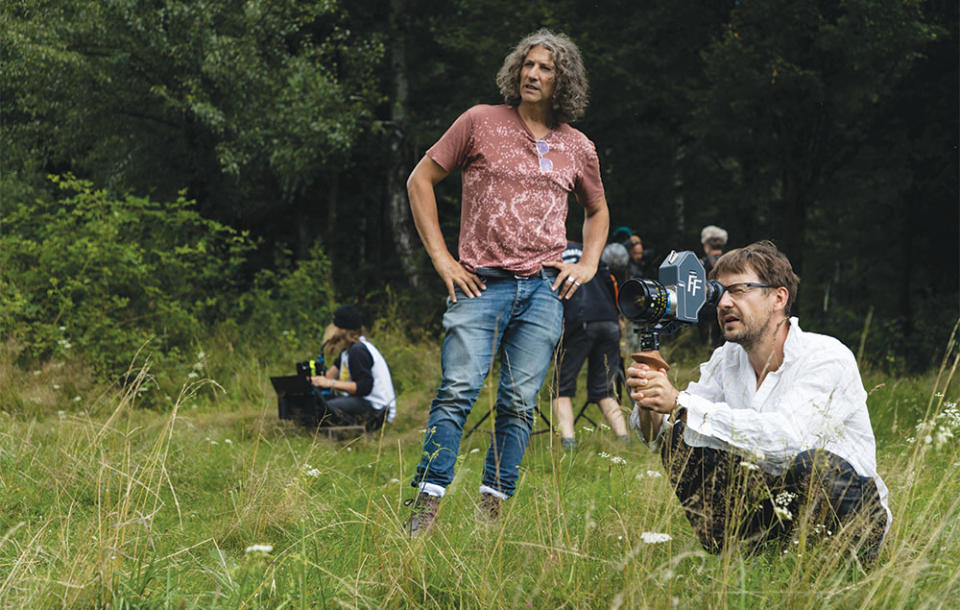
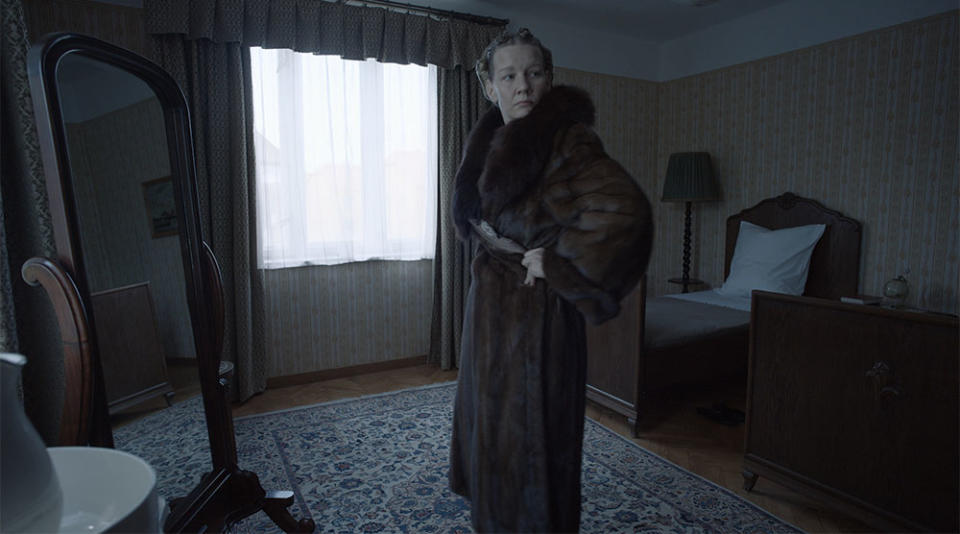
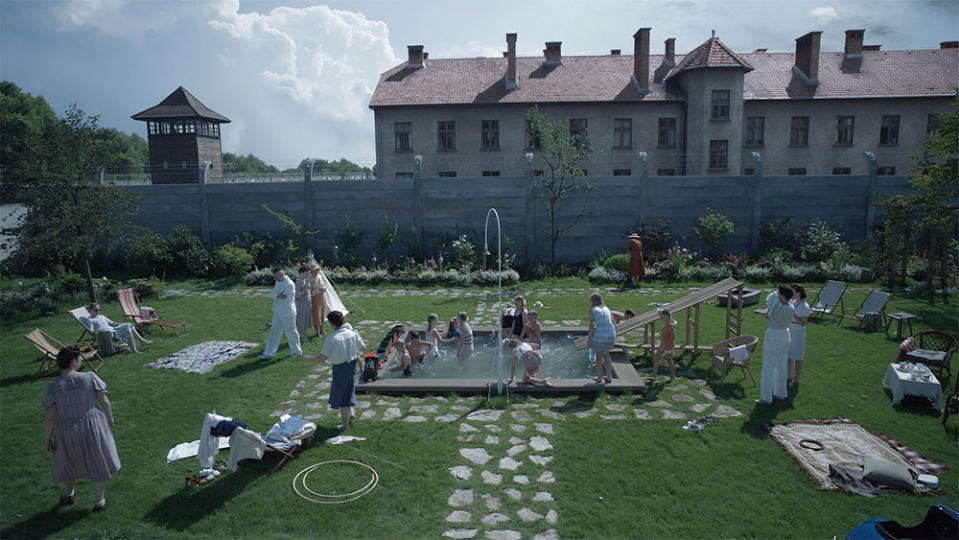
The only scene shot in the original house comes late in the film, where Rudolf walks from his office through the real underground tunnel that connects the camp with his home.
Oddy found another building, an abandoned house a few hundred yards from the Hösses’, built after World War II but in a similar architectural style, with grounds that also butted up against the camp wall. Consulting photographs from the Auschwitz museum’s vast library, the Hösses’ own family photos and aerial photos — “some of them very high resolution, taken with plate cameras on a tripod, nice and still with incredible detail” — he set about rebuilding.
The abandoned residence “didn’t have stairs, a porch or the same number of windows, so it was basically a full renovation of the house,” says Oddy. “Jonathan was clear everything had to have a fresh, new feeling, as if it had been built yesterday, because that’s what it was like then. And everything had to be functional, so all the toilets flushed. We had hot and cold running water. All the lamps worked.”
Hedwig Höss’ garden was her pride and joy. A key scene in the film shows Hedwig, played by Sandra Hüller, taking her mother on a tour, boasting of every detail, every flower, noting that Rudolf calls her the “Queen of Auschwitz.”
For the film, Oddy repurposed the scrubby allotments surrounding the house and rebuilt that garden, transplanting trees and seeding flower beds. He started more than a year beforehand to give the plants a chance to grow.
“That was when it was literally spades in the soil, that it became really difficult for me. Because I had to make the garden in their image. I had to start to get inside Hedwig and Rudolf’s heads and think about what sort of design, what sort of aesthetic they would aspire to,” says Oddy. “This kind of closeness to them, to their Nazi ideals and aspirations, was something I found very, very difficult — and not something I think I’m going to get over.”
Getting uncomfortably close to the Höss family was at the core of Glazer’s vision for Zone. It was paramount to get rid of anything that would place their story, and that of the Holocaust, safely in the past, “where it feels like a museum piece,” says Glazer, “and we can say: ‘Oh, it’s just a movie.’ ”
That approach informed every aspect of the film’s production. All the costumes, says costume designer Malgorzata Karpiuk, “had to look new, not like in a period movie, not vintage, but newly made. We custom-made 90 percent of Hedwig’s dresses and almost everything of Rudolf’s, basing the designs on photographs and eyewitness descriptions from diaries and other historical material.”
To look as modern as possible, The Zone of Interest was shot in color on digital cameras with high-tech lenses and 6K resolution. “We wanted to see every pixel,” notes cinematographer Lukasz Zal.
Early on, one of the “dogmas” Glazer set for the film was no artificial light. Every light source had to be natural — noon sun was noon sun, natural moonlight was natural moonlight — or had to come from the oil lamps, electric bulbs or candles in the Höss house.
“It was a completely different approach, which meant forgetting everything I’d been taught about lighting,” says Zal. “You know, trying to shoot with a nice backlight or during the golden hour to make everything beautiful. We shot in natural light, always. Even when it was ‘ugly.’ ”
And when there was no natural light available, they shot without it. The scenes, based on a real-life character, showing a Polish girl who sneaks out at night to smuggle fruit to the prisoners in the camps, were filmed with a thermal camera used by the Polish military.
“What you see isn’t light, it’s heat,” says Glazer. “It was shot on what is essentially a military surveillance camera. We had to have someone from the Polish army with us every time we took it out of the box, because it’s officially classified as a weapon.”
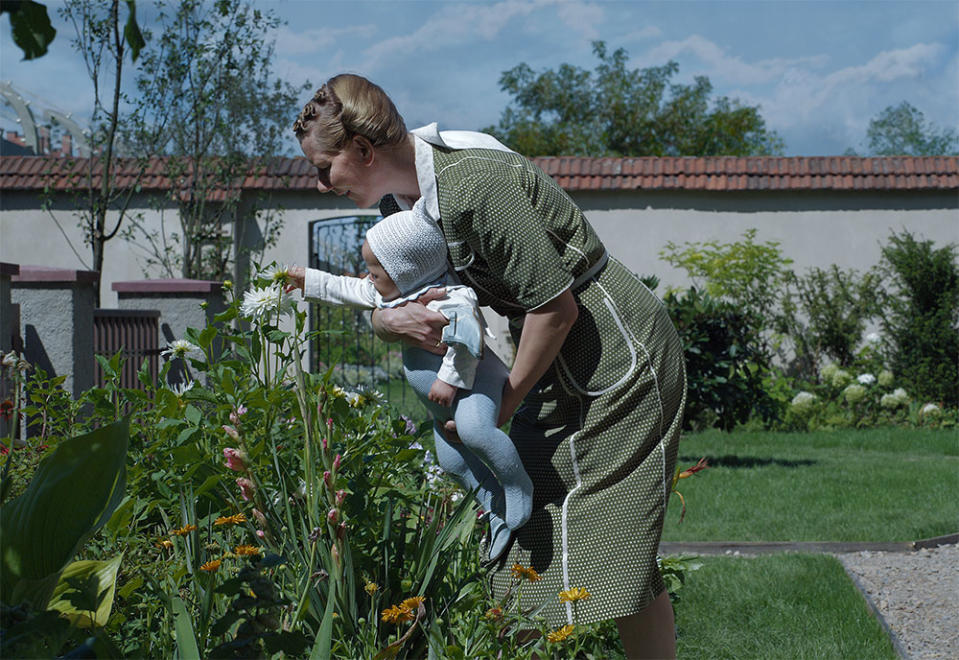
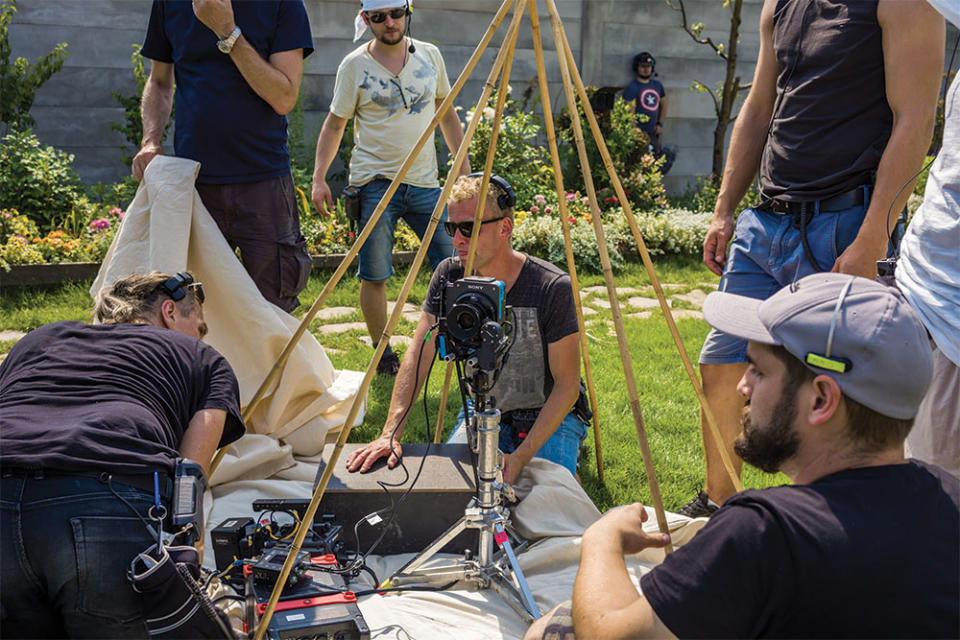
The resulting images are flat, strange and high tech, as if they came from a computer-generated video game.
“It was all part of the same dogma, of seeing this story through a 21st century lens,” says Glazer. “Even if it’s very different or jarring, it comes in the same mindset, for the same desire to look at everything unadorned.”
Part of this 21st century approach involved using multiple cameras to create a panopticon surveillance system that would capture each scene from multiple angles. The house Oddy built was wired with 10 digital cameras and about 20 microphones, plus mobile mics for the actors.
“I drilled some 30-odd holes throughout the house for the cables to connect all the cameras, — the place was like Swiss cheese,” says Oddy.
Zal and his team, including the focus pullers for each camera, were stationed in the basement, away from the actors. Glazer and the rest of the crew were on the other side of the wall, in a container refurbished to look like part of the camp. All were connected via fiber-optic cable. Glazer called the setup “Big Brother in a Nazi house.”
Says Christian Friedel, who plays Rudolf Höss: “It was an almost documentary approach. Because there was no crew on set, you could move where you wanted; we had incredible freedom.”
Each take would be 10 minutes, the length of time on the cameras’ digital memory cards. Glazer, watching and listening to a simultaneous English translation of the actors’ performance, would occasionally dart in between takes to give instructions.
“Even though he doesn’t understand German, he always noticed when my performance was too much,” says Friedel. “He’d say to me: ‘You have tension in your body, like a drawn bow, but you can never let it fly. We can’t ever see Rudolf’s aggression, see him as the perpetrator, the murderer, but we always have to sense it.’ There was someone more interesting under the surface, which, in a way, is the whole concept of the film.”
Friedel and Hüller say they were at first hesitant to take on the roles, worried about how the Nazi era, and the couple, a pair of true fascist believers, would be portrayed.
“I’ve been offered [to play] Adolf Hitler twice and [Nazi leader] Rudolf Hess once, and I turned it down, because they were clichéd portrayals, and that didn’t interest me,” says Friedel. “But Jonathan’s approach, to show [Rudolf Höss] as a boring bureaucrat in everyday situations, to give this monstrous person a human face, that interested me.”
“I never wanted to play a Nazi, never,” adds Hüller. “I had a big problem trying to relate, emotionally, to Hedwig. I refuse to do so.”
The solution for Hüller was to portray Hedwig as being, in Glazer’s words, in a state of “perpetual non-thinking.
“I remember saying to Sandra: ‘Never stop moving, keep going from one activity to the next, so you’ll never be tempted to stop and reflect,’ ” says Glazer. “When you see her performance, that’s what you see, and what is remarkable is her commitment to playing this non-thinking, non-reflective, selfish human being.”
Ironically, perhaps, this approach, emphasizing the ordinariness of Rudolf and Hedwig Höss, makes these monstrous humans all the more relatable.
“Many say the film shows the banality of evil, and it does, perhaps more than other films have done, but I hope it goes beyond that,” says producer Wilson. “One of the people who worked on the movie, a German script consultant, said: ‘Rather than just ask the question how could ordinary people do such terrible things, it asks: How like them are we?’ That’s a different, maybe more interesting and definitely more disturbing question.”
And it’s a question, says Wilson, that became the film’s North Star. Throughout development, Glazer took pains to take out anything in the script that made the Hösses’ life less than ordinary.
“We originally had a lot more plot — the book has a lot of plot, there’s a romance story, a story of the resistance — but we threw all that out,” he says. “We initially had several scenes in the camp, but we kept coming back to the Hösses’ domestic life, to their garden and that Big Brother house.”
The approach even extended to the framing of shots. Instead of combining wides and close-ups, using the language of cinema to indicate drama and suspense, Glazer asked cinematographer Zal to shoot almost everything in a medium shot.
“We were composing our frames in the most simple way possible, so we were looking straight at them,” says Zal. “Jonathan had the idea that the cameras together would be like one big eye that could see everything, erasing our interpretation to become almost objective.”
The Big Brother setup produced a mountain of material, both video and audio. Zone editor Paul Watts received 15 to 20 hours of video rushes per day — “normally the kind of footage you might get in a week or two” — adding up to a total of “800 to 850 hours of video and some 12,000 to 16,000 hours of sound rushes” to sort through.
One thing Watts didn’t have to worry about was continuity. Because of the way Glazer shot the film, with multiple cameras filming each scene from all possible angles, Watts could “cut wherever we wanted to cut and everything was always perfectly in sync.” Virtually every scene that ended up in the film was from a single take. “We almost never cut between takes,” says Watts.
With no worries about continuity errors, Watts and Glazer could scan the reams of footage for surprises, for moments when an actor did or said something unexpected. In one scene, two of the Höss boys are playing in their room. Luis Noah Witte, the young actor who plays Rudolf and Hedwig’s son Hans, sits on his bed and starts mumbling under his breath: “Boom, boom, boom.”
“It wasn’t scripted, but it caught our eye,” says Watts. “We thought: ‘We can reframe this. [Sound editor] Johnnie Burn can add in a noise to have him react to something beyond the wall.’ ”
In the final version, we can hear, along with Hans, in the distance the steady, muffled “boom, boom, boom” of the camp’s machines.
“Me and my team spent a year out recording the sounds of different industrial processes from a distance — bottling factories, industrial incinerators,” says Burn, “but also different military period vehicles and guns from the period, testing how they would sound when fired from the correct distance, taking into account the echoes, the recoil. It was all very methodical.”
Burn added in the noises of regional and era-appropriate fauna — “the kinds of birds, the bees that would have been there at the time, the sort of cars or trains that would pass by on the road” — with live recordings, some from actors, some captured in real-world spaces, including “the protests in Paris a couple of years ago, or the sound of nightlife in Berlin,” to create a library of thousands of sounds. Sitting down with Watts and Glazer during the edit, they would move back and forth through scenes, exploring variations on individual takes, adjusting how the mood of the story changed when they added the snap of a distant gunshot or the rumble of a train bringing in another load of prisoners to the camp.
“We went though the film and cut it so that the story of the whole family drama would work, then we went back through and edited it to sound like a horror film,” says Burn.
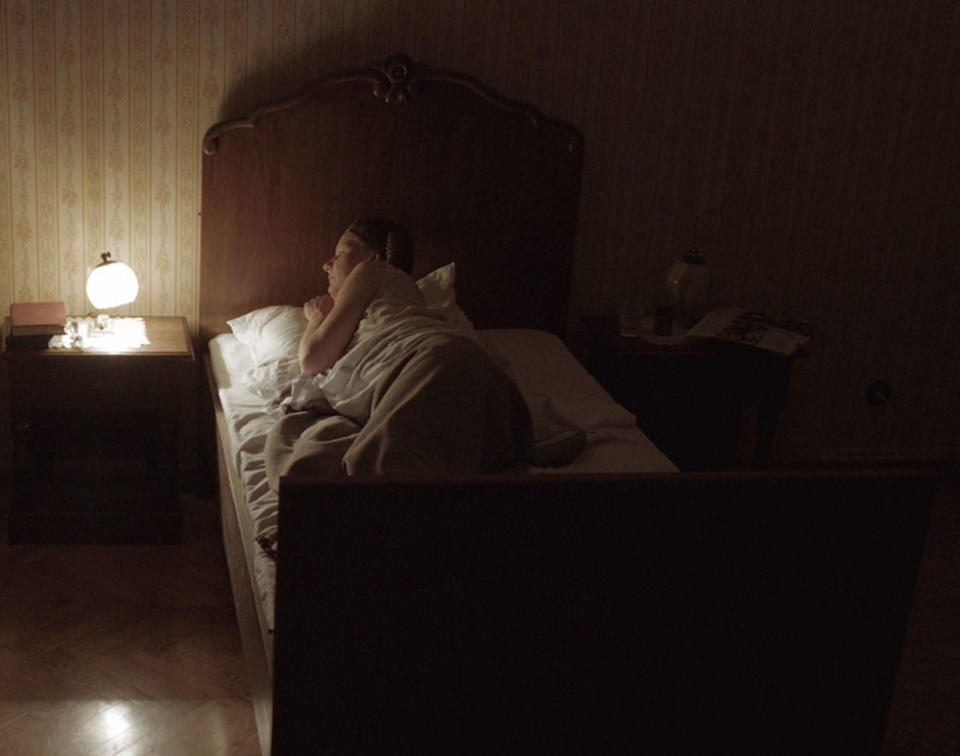
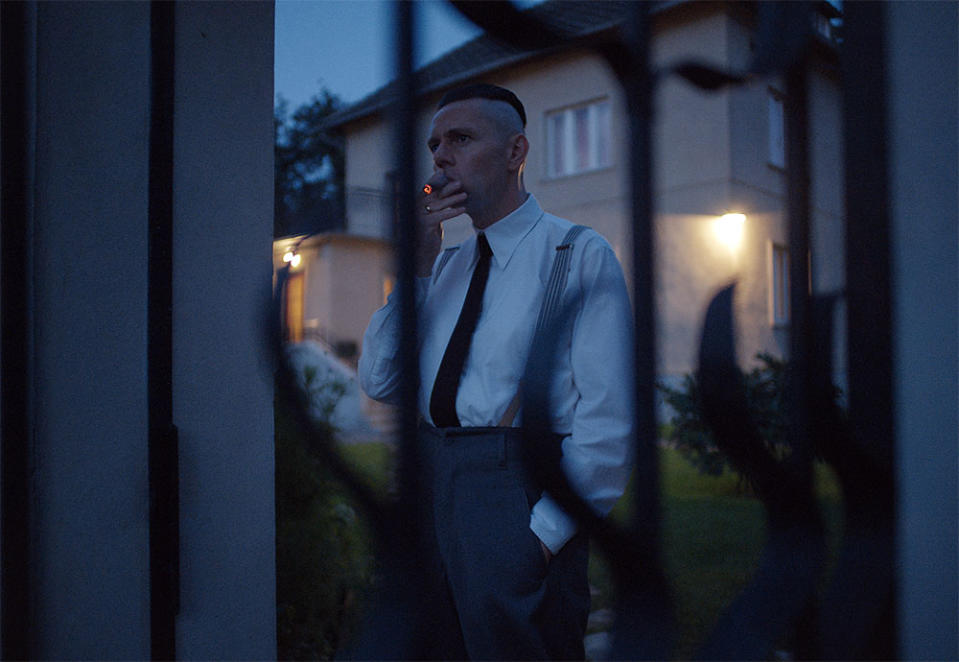
All the while, Mica Levi, who composed the film’s striking score, was writing musical cues and sequences, which Watts and Glazer were using as placeholder tracks to structure scenes.
“Mica spent the better part of a year in the edit room with Jon and me,” says Watts. “Their sounds shaped the editorial, even when we ended up not using the music in the final version.”
“I wrote a lot of music, really trying a lot of things, leaving no stone unturned,” says Levi. “But as Johnnie [Burn] started really getting going and adding in his sounds, we saw the music was at odds with it, it wasn’t really working.”
Together, they began stripping the music out, removing it from the entire film except for short electronic moans heard over the brief scenes of thermal footage of the Polish girls leaving food for the prisoners — “we called them the yums,” says Levi — and the haunting tracks heard over the black screens that open and close the film. Both pair wailing human voices — “the oldest, most primordial instrument,” says Levi — with “the most modern”: an electronic synthesizer.
“My understanding of what Jon wanted to do with this film was to show this history through a 21st century lens,” Levi says. “Because even though this is a historical event, it’s a reflection of the human condition, the human capability that is within all of us and indeed is happening right now with oppression and occupations, the disregard of human life, the genocides.”
Levi’s first track, called “Entrance,” plays over a black screen and features a very slow, microtonal descent in pitch, taking you, in Watts’ words, “out of the world of 2023 and down into this place and this time.”
“Starting the film with a blank screen is also a way of saying to the viewer: ears before eyes,” says Glazer. “That what you are going to hear, the sound of the atrocities committed on the other side of the wall, is as significant as what you’re going to see.”
The piece at the end, “Exit,” features a slow ascending pitch, “as you resurface somehow from the film back into the world,” says Levi.
There is one other musical cue in the movie. Hedwig is tending to her garden. The bucolic images onscreen, close-ups of every last beautiful flower, jar with Burn’s horrific soundscape of barking dogs, screaming guards and the distant howl of a prisoner in pain. Suddenly, the screen cuts to red and there is utter silence. Levi drops in a deep inhuman sound, like the roar of a satanic bellows.
The scene was a four-way collaboration, as Watts, Burn, Levi and Glazer were editing together — linked by Zoom. Over a close-up of a bright red rose, “My sound ran out,” says Burn. “It was Mica who said: ‘Why don’t we sort of break the fourth wall and kind of burn out the screen?’ Paul [Watts] had the idea of cutting to red. He AirDropped a simple red graphic to me, and I chucked it in the timeline. Then Mica went, ‘I think it needs to go boop,’ and they tried a few things. In the space of 30 minutes, we had it.”
This was late in the day, mere weeks before The Zone of Interest was set to screen at Cannes.
“But you have to understand, Jon never locks picture, that’s how he works,” says Wilson. “We spent 18 months editing this film, but everything remained always open, till the last.”
Production designer Oddy calls it “jazz filmmaking.” Levi describes Glazer’s process as “trying to pin a dress on someone who’s dancing.”
Even after the Cannes premiere, Glazer went back and made tweaks, adding a short but significant shot with Rudolf and his son that was not in the original edit.
The film’s final scene, before it cuts to black and to Levi’s exit music, is of documentary images of modern-day Auschwitz. Cleaners vacuum the carpets of the camp museum and wash the glass cases containing piles of shoes, clothes and suitcases. It’s the ultimate expression of Glazer’s approach with The Zone of Interest: to tell the story of the Holocaust not “as something safely in the past,” the director says, “but quite the opposite, that this is a story of the here and now.”
Says Wilson: “We’re not Nazis, but we have some of the same behaviors that we see in the Höss family, of compartmentalizing, of looking away, ignoring what is happening beyond the wall. That, I suppose, is what the film is trying to say, reduced to a one-liner: Is there anyone over your wall?”
This story first appeared in a December standalone issue of The Hollywood Reporter magazine. Click here to subscribe.
Best of The Hollywood Reporter

